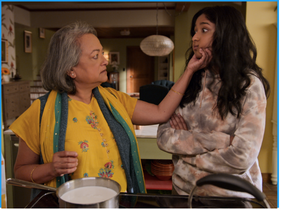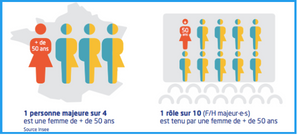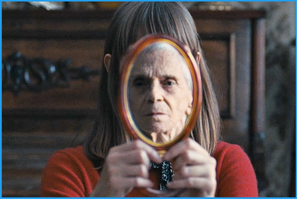FOCUS
#16
Invisibility, the superpower of women over 50 on screen
In association with AAFA – “Tunnel de la comédienne de plus de 50 ans”, a commission of AAFA – Actrices & Acteurs de France Associés. This committee fights sexist stereotypes linked to women’s age, produced in film. Its aim: to question this phenomenon of invisibility, to name the problem, to break stigmas, and to rectify the representations of women over 50 in the media.
Overview : While 52% of adult women are over 50, only 9% of roles in French films released in 2020 went to actresses over 50. Women over 50, despite being in the majority demographically, are invisible in cinema and television. What’s more, when they do appear on screen, they are the target of a large number of stereotypes. Within the film and audiovisual industry, under the impetus of AAFA – “Tunnel de la comédienne de 50 ans”, professionals are beginning to take action. Film has a role to play in combating sexism and ageism.
In France, 52% of adult women are over 50, i.e. 28% of the total adult population. Yet in 2020, only 9% of all roles in French films went to actresses over 50. Women over a certain age are therefore invisible on screen.
Women on screen, women don’t age… they disappear !
Journalist Betty Friedan describes the system as twofold: on one hand, what amounts to an “obsession” with old age, often portrayed as a problem, and on the other, a “curious absence” of media images of ageing women.
As is often the case, however, women and men are not treated equally. The American essayist Susan Sontag has shown that women are considered “old” earlier than men, in a construct that’s more in favor of male ageing. What’s more, when they do appear on screen, they are often associated with negative representations. Cinema, television and advertising all reproduce the image of saintly, asexual mothers.
In the series “Never Have I Ever” (2020-present), while the schoolgirl Devi, her cousin, and her mother all have love affairs, the grandmother (and widow) Nirvala devotes herself as a homemaker. She never meets anyone again, romantically. A horrifying or demonised view of older women is conveyed in “Abuela” (2021), portraying an elderly woman, who has suffered a cerebral haemorrhage, and whose decaying body is shown in contrast to her photos when she was young and beautiful. Finally, in “Hereditary” (2018), the grandmother practises witchcraft and causes violent trauma on her children.

Devi and her grandmother in
“Never have I ever” (2020-currently)

The place of women and men aged over 50
in French society and in cinema in 2020.
Infographics produced by AAFA – “Tunnel de la comédienne de plus de 50 ans“
The weight of images and standards of femininity weighing on older women
These representations are intrinsically linked to the values conveyed by what Swiss journalist and essayist Mona Chollet calls the “fashion-beauty complex”. While the industry largely spares unfair standards on men, it forces women to look like models of beauty – with no trace of age. Representations in the media, films and advertising help to shape our conceptions of women’s bodies, excluding all those whose bodies no longer correspond to the dominant cultural criteria on “feminine beauty”. According to Geneviève Sellier, historian and specialist in gender in cinema, films actively contribute to the stigmatisation of ageing actresses, who are too often under-represented. All in all, the images on our screens play a large part in reproducing the sexist and ageist discrimination at play in society.

Abuela (2021)
Turning the tables through film
The AAFA – Actrices & Acteurs de France Associés, the AAFA – “Tunnel de la Comédienne de 50 ans commission” was created in December 2015. This committee questions the lack of representation of women over 50, calling out the problems with these portrayals, breaking stigmas. Its members fight for visibility as well as combating against sexist stereotypes linked to women’s age – continuously being perpetrated in the media. Questioning the portrayal of women over 50 in fiction also means questioning the power dynamics between men and women in film. After menopause, women who can no longer procreate are of little interest to mainstream stories. Their confidence, psychological, emotional and professional maturity don’t interest those controlling the stories being told in the media. To combat these inequalities in representation, the commission, co-directed by Marina Tomé and Catherine Piffaretti, have set up initiatives to raise awareness of the issue. It regularly publishes the Counting the Roles in French Films, an insight into ageism and sexism on screen. They work with sociology researchers to reflect on ageist and sexist discrimination, its causes, and the social challenge it represents. They propose concrete actions that still respect creative freedoms via the AAFA – Tunnel des 50 manifesto, which now has more than 15,000 signatures. It has even obtained the attention of studies conducted at institutions such as the CNC and Adami.
Tunnel de la comédienne de plus de 50 ans: A movement against the invisibilisation of older women on screen
The AAFA – Actrices & Acteurs de France Associés, the AAFA – “Tunnel de la Comédienne de 50 ans commission” was created in December 2015. This committee questions the lack of representation of women over 50, calling out the problems with these portrayals, breaking stigmas. Its members fight for visibility as well as combating against sexist stereotypes linked to women’s age – continuously being perpetrated in the media. Questioning the portrayal of women over 50 in fiction also means questioning the power dynamics between men and women in film. After menopause, women who can no longer procreate are of little interest to mainstream stories. Their confidence, psychological, emotional and professional maturity don’t interest those controlling the stories being told in the media. To combat these inequalities in representation, the commission, co-directed by Marina Tomé and Catherine Piffaretti, have set up initiatives to raise awareness of the issue. It regularly publishes the Counting the Roles in French Films, an insight into ageism and sexism on screen. They work with sociology researchers to reflect on ageist and sexist discrimination, its causes, and the social challenge it represents. They propose concrete actions that still respect creative freedoms via the AAFA – Tunnel des 50 manifesto, which now has more than 15,000 signatures. It has even obtained the attention of studies conducted at institutions such as the CNC and Adami.
Turning the tables through film
As part of her sociology research at the Université du Québec à Montréal, Julie Silveira shows that there are a few films that portray atypical female figures who are rarely seen in cinema. In Rainer Werner Fassbinder’s “Tous les autres s’appellent Ali” (1974), an elderly German worker marries a younger Moroccan man. John Cassavetes’ “Opening Night” (1977) tells the story of how an ageing actress overcomes the fear of getting older, imposed on her by society, by successfully playing the role of a woman who has lost her youth.

Emi and Ali in
“Tous les autres s’appellent Ali” (1974)
In “Trente tableaux” (2011), Paule Baillargeon looks back at the defining scenes in her life as a filmmaker, mother, feminist and artist.

Grace and Franky (2015-currently)
More recently, in “Les Jeunes Amants”, Fanny Ardant plays a 72-year-old woman who is having a love affair with Melvil Poupaud, a much younger man. This is a rare occurrence in cinema, since the majority of heterosexual couples who appear on screen, and without considerable age gaps, are consistently made up of men of a certain age and women whose age is stagnant. Aurélie Saada’s film “Rose” (2021), starring Françoise Fabian, highlights the injustices associated with older women’s bodies and lives in media. Another example is the series “Grace and Frankie” (2015 – present), starring Jane Fonda and Lily Tomlin, which explicitly shows the realities associated with the a lack of representation, featuring two heroines in their seventies… completely flipping the script on gender and age stereotypes!
The Observatoire des images, created in 2021, is the first associative body to bring together all those interested in the role of images in cinema, television, video games and advertising, particularly on the Internet.
The coalition’s objectives include: raising awareness among public authorities, professionals and the general public; developing research into the reception of images and highlighting existing work; pooling and supporting professional practices; promoting projects and teams committed to combating stereotypes.
Join us : observatoiredesimages.org

